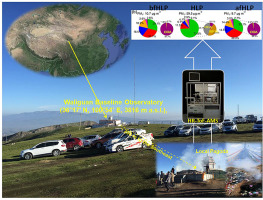当前位置:
X-MOL 学术
›
Atmos. Environ.
›
论文详情
Our official English website, www.x-mol.net, welcomes your
feedback! (Note: you will need to create a separate account there.)
Chemical characterization of submicron particulate matter (PM1) emitted by burning highland barley in the northeastern part of the Qinghai–Tibet Plateau
Atmospheric Environment ( IF 4.2 ) Pub Date : 2020-03-01 , DOI: 10.1016/j.atmosenv.2020.117351 Xinghua Zhang , Jianzhong Xu , Shichang Kang
Atmospheric Environment ( IF 4.2 ) Pub Date : 2020-03-01 , DOI: 10.1016/j.atmosenv.2020.117351 Xinghua Zhang , Jianzhong Xu , Shichang Kang

|
Abstract Tibetans in the Qinghai–Tibet Plateau (QTP) commonly burn highland barley during their traditional festivals. However, few studies have been focused on the physical and chemical properties of the particles emitted when such biomass is burned. A comprehensive field study was conducted on the top of Waliguan mountain (3816 m a.s.l.) at the northeastern border of the QTP to provide insights into aerosol characteristics in this remote site during July 2017 during which one of the most important Tibetan festivals (known as “Weisang”) occurred on 5–6 July. Extremely intense aerosol emissions occurred between 23:00 on 5 July and 08:00 on 6 July, and the dominant chemicals emitted in submicron particular matter (PM1) were organic aerosols (OAs) measured through a high-resolution time-of-flight aerosol mass spectrometry (HR-ToF-AMS). Fresh biomass burning OA (BBOA) and traffic-related hydrocarbon-like OA (HOA), decomposed by positive matrix factorization analysis on the OA high-resolution mass spectrum, contributed ~90% of the OA during the event. The BBOA mass spectrum was found to be very similar to that of traditional wood identified by HR-ToF-AMS, but with fewer nitrogen-containing species and a higher m/z 60 to 73 signal ratio. The BBOA emission factor during the event was 2.28 g kg−1, which was comparable to emission factors found for burning wheat, grass, dung, and hardwood in previous studies in Himalayas. The particle light extinction coefficient and the cloud condensation nuclei number concentration were clearly increased during the period of burning highland barley, suggesting that the aerosols emitted could significantly affect radiative forcing and cloud properties in the QTP.
更新日期:2020-03-01











































 京公网安备 11010802027423号
京公网安备 11010802027423号